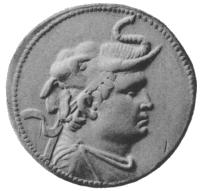Sirkap
Sirkap (Urdu and Punjabi: سرکپ) is the name of an archaeological site on the bank opposite to the city of Taxila, Punjab, Pakistan.Numerous Hellenistic artifacts have been found, in particular coins of Greco-Bactrian kings and stone palettes representing Greek mythological scenes.Gondophares, the first king of the Indo-Parthian Kingdom, built parts of the city including the double headed eagle stupa and the temple of the sun god.A Greek religious temple of the Ionic order is also visible at the nearby site of Jandial (650 meters (2,130 ft) from Sirkap), but there is a possibility that it may have been dedicated to a Zoroastrian cult.The site of Sirkap bears witness to the city-building activity of the Indo-Greeks during their occupation of the Indian territory for close to two centuries, as well as their integration of other faiths, especially Buddhism.The Greek philosopher Apollonius of Tyana is related to have visited ancient India, and specifically the city of Taxila in the 1st century AD.




GandharaIndo-GreekSir John MarshallUNESCO World Heritage SitePunjabiarchaeological siteTaxilaPunjabPakistanGreco-BactrianDemetriusMenander IMortimer WheelerIndo-ScythianIndo-ParthianStone paletteJohn MarshallHippodamianOlynthusMacedoniaAi-KhanoumArtemisIndo-ScythiansIndo-ParthiansGondopharesIndo-Parthian KingdomKushanSirsukhNereidHarpocratesDionysusHellenisticBuddhiststupasIonic orderJandialZoroastrianHaritiIndo-GreeksDouble-headed eagleBabylonianScythiaDharmarajika StupaBuddhaApollonius of TyanaNinevehJain TempleBhir MoundGandhara kingdomAchaemenid invasion of the Indus ValleyGreek conquests in IndiaMauryan EmpireGreco-Bactrian kingdomIndo-Greek kingdomKushan EmpireAlchon HunsTurk ShahisHindu ShahisGhaznavid EmpireGreco-Buddhist artGreco-BuddhismHellenistic influence on Indian artSilk Road transmission of BuddhismPeshawarTakht-i-BahiSahr-i-BahlolBaho DheriAziz DheriShaji-ki-DheriKanishka stupaLoriyan TangaiJamal GarhiButkara StupaBhamalaAhin PoshSaidu SharifBarikotCharsaddaPushkalavatiRanigatHashtnagarSikri stupaDharmarajikaJaulianKalawanMohra MuraduKunala StupaMankialaAfghanistanTapa ShotorChakhil-i-GhoundiShotorakPaitavaBimaranMes AynakFondukistanKhair KhanehSphola StupaTapa SardarTepe NarenjTepe MaranjanAramaic Inscription of TaxilaBimaran CasketKanishka reliquaryStone palettesBuddhas of BamiyanBuner reliefsSaptarishi Tila statuePost-Mauryan coinage of GandharaKabul hoardShinkot casketRukhuna reliquaryTreasure of BegramWardak VaseStanding BuddhaBrussels BuddhaBajaur casketSilver Reliquary of IndravarmanHephthalite silver bowlGardez GaneshaHathialSarai Khola